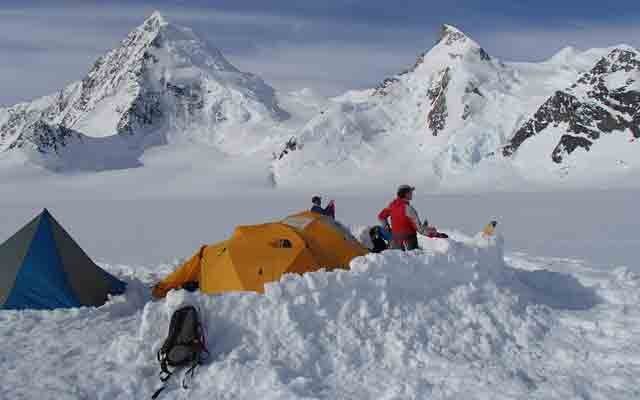Compared to the mountains of the Yukon's Kluane National Park, the peaks of the Canadian Rockies are small hills.
The value of lessons shared in those Yukon mountains through training sessions between members of the Rockies and Kluane national parks staff, however, is very big.
Earlier this season, Parks Canada visitor safety specialists Ian Jackson, from Banff/Yoho/Kootenay, and Jasper's Max Darrah, spent 10 days running a training program with three resource-conservation staff members based in Haines Junction, Yukon.
The main focus of the program involves providing basic mountain-rescue training for the Kluane staff. Every spring public safety staff from the southern parks travel to Kluane and (though not this year) Auyuittuq in Baffin Island, where the staff don't have all the skills necessary to carry out technical mountain rescues. In the event of a serious rescue in difficult terrain requiring technical climbing skills or heli-sling evacuation, visitor safety specialists from the southern parks would travel north to carry out the rescue.
Jackson and Darrah are both internationally certified ACMG/IFMGA mountain guides with extensive technical-climbing and mountain-rescue experience. With millions of tourists visiting Banff, Yoho, Kootenay, Jasper, Waterton Lakes and B.C.'s Glacier Park every year, particularly through the summer months, 15 dedicated visitor safety specialists are assigned to ensure their safety. In the 2012 season, the Banff and Lake Louise/Kootenay/Yoho field units responded to a total 335 rescues. Helicopters were used for half the rescues, with long-line sling rescues making up about one-third of the calls.
In Kluane, technical rescues requiring a long line happen less than once a year, but when they do, they're usually serious. At 21,980 square kilometres, Kluane is more than double the size of Jasper, but almost entirely without any roads.
Climbers who are dropped off on immense glaciers for multi-week expeditions are experienced and well prepared to manage emergencies on their own, understanding that a technical rescue is at a minimum one day, or often a week, or longer, away. Usually those needing rescue have the ability to self-evacuate to a helicopter pick-up spot.
"The terrain is vast on an almost unimaginable scale," Jackson said. "Glaciers can be 20 kilometres wide. It sort of makes the mountains down here look like little hills ... It's really remote, huge landscape, really long daylight hours, with twilight for a few hours every night. It was my first time experiencing that."
While at Kluane, Jackson and Darrah worked with Scott Stewart, David Blakeburn and Sarah Chisholm, who, along with one manager, are responsible for less technical rescues. They practiced crevasses rescue, avalanche-hazard assessment and backcountry-travel leadership skills. They also spent a day with Trans North helicopter pilot Dion Parker practicing heli-sling rescue techniques.
And, with Darrah and Jackson, the three Kluane staff spent six days camped at 2,600 metres on the glacier at the base of one of the region's smaller mountains, 3,714-m Pinnacle Peak (slightly higher than Banff's Mount Temple). A 45-minute helicopter flight from Haines Junction, it's the highest peak in that area.
Overall, it was a productive trip, Jackson said, and while they were fortunate to enjoy mostly clear skies — a local rarity — a 30-cm snowfall prevented them from summiting. For the Kluane staff, the trip marked their first opportunity to train on the ice and build their mountain travel skills.
"Everyone was psyched on all the skills they were able to learn and practice," Jackson said. "For me, I definitely felt a part of the regional Parks Canada team."
While it was Jackson's first time participating in a northern-training trip, Darrah has responded to a rescue call in Kluane, participated in training and worked there as a warden
"These are the biggest mountains in Canada," Darrah said. "Every time I'm up there, you feel pretty small. You realize how big the glaciers are, how great the distances are. The sense of remoteness is powerful."
A highlight of the trip was a recon flight to the west end of Logan, right over the fabled Hummingbird Ridge and East Ridge climbing routes.
Having a look at the standard routes on Logan and also on Mounts Kennedy, Alverstone and Hubbard was time wisely spent, Jackson said, as knowledge of the local geography, including dynamic, shifting glaciated terrain would be of high value for southern staff members called up for a rescue.
For the Kluane staff, the flight was valuable too, as their training included learning how to make assessments from the air to decide if a situation warrants summoning the southern specialists.
"One of the big roles in technical rescue would be to fly in and make assessment, decide if they need us, what gear to bring," Jackson said. "They need to be able to make that evaluation from the air. It definitely takes a lot of experience in the mountains."
The second purpose of the training visit was to provide an opportunity for the southern staff to gain some familiarity with the region's geography, and to know the pilots and radio frequencies. As well, by working and training together, northern and southern staff get to know each other's skills and abilities.
"That's a big part of the value of working with colleagues we may work with in the future," Darrah said.
Last year's training focused on pilot training; one specially-trained pilot is stationed in Kluane.
By scheduling the training in the late spring, the staff take advantage of Kluane's busy season which, coincidentally, is the slow time in the southern mountains.
And, both last year and again last month, right after the training exercise, the Kluane staff had a rescue.
"This year it was the day after we left," Jackson said. "The team was able to take care of it. That definitely validates our training."




